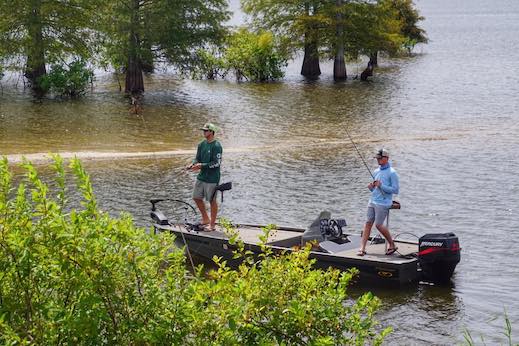Toledo Bend Reservoir Fishing Charters & Guides
- 21ft Center Console
- Max Guests
- From $0.00
- View Available Trips
- 24ft Bay Boat
- Max Guests 6
- From $350.00
- View Available Trips
- 24ft Center Console
- Max Guests 3
- From $550.00
- View Available Trips
- 18ft Center Console
- Max Guests 4
- From $600.00
- View Available Trips
- 24ft Center Console
- Max Guests 4
- From $650.00
- View Available Trips
- 25ft Bay Boat
- Max Guests 4
- From $600.00
- View Available Trips
Toledo Bend Reservoir Fishing Charters
At 185,000 acres, the Toledo Bend Reservoir on the Sabine River is the fifth largest man-made impoundment in the U.S. and the biggest in the South. It is a short drive south of Shreveport. The lake is partly in Texas and partly in Louisiana. The state line follows the river channel through the lake so it meanders instead of taking a straight line. The state line is close to the shoreline on either side depending on the exact location in the lake. The lake was created in 1967, which explains why the border wanders so much. You can fish Toledo Bend with a Texas or a Louisiana fishing license as long as you stay on the water. The states have a reciprocal agreement regarding the lake. If you get out on the bank, you need a license from that state to fish from the bank.
Bass Fishing Toledo Bend Reservoir
Toledo Bend fishing charters target largemouth, hybrid, white and striped bass. The lake also has spotted bass but these are usually an incidental catch when chasing largemouth. The lake is routinely in the top 10 in the nation for bass fishing. Largemouth bass are the top freshwater fish here. Old Bucketmouth is a voracious feeder and can reach double-digit weight in just a few years thanks to the abundance of prey and the year-round moderate temperatures in Toledo Bend. Anglers chasing a wall-hanger see best results using large shad, also called shiners or roaches. Bait the size of your hand makes sure smaller bass stay away. Fish without lead weight. A cork can be used but is not necessary. The Toledo Bend Lake Association (TBLA) offers free replicas to every angler who catches a bass larger than 10 pounds, enters it into the program and agrees to release it. The TBLA has dumped more than 28 million Florida-strain largemouth into the lake over the years. Bucketmouth are around structure because that is where the prey congregates. Bigger bass are in deeper water. Use fish finders to locate underwater structures. Top lures in no particular order are: spinnerbaits, jigs, plastic worms and lizards, topwater popping plugs, crankbaits and tube lures. While largemouth fishing is 24-hours a day, striper fishing is best just before dawn to a bit afterward. Stripers chase baitfish in the dawning light. Toledo Bend fishing charters want to be on the water and in place before the sun rises. Stripers can also be found occasionally beneath baitfish at the surface. Top lure are big jigs, especially white butter bean jigs and live bait. The white bass looks a lot like a striper, but never gets to the same size. White bass are found out in the open lake when not spawning. They school in big numbers so when you find one, many more are present. Tube lures and small jigs are ideal. The hybrid is a cross between the white and striped bass. It gets bigger than white bass, not as big as a striper and schools like white bass. Whites and hybrids can often be found feeding on the same school of baitfish. The same techniques and lures work on both.
More Fishing in Toledo Bend Reservoir
Bream is a catchall term for the sunfish species. No matter which one you catch, these scrappy fish are plentiful and easy to catch with worms and crickets. They also eagerly take small spinnerbaits, tiny crankbaits and slurp any fly small enough to fit in their mouth. With steady action and generous creel limits, bream is an ideal fish for children. Fish around trees dipping into the water and cypress trees. Crappie, pronounced "CROP ee", is another schooling fish. Many anglers drop old Christmas trees into the lake to serve as fish attractors. Many an angler has caught a limit from one stand of sunken trees. Swim or hair-tailed jigs, minnows and small crawdads are the best baits. Crappie are also caught trolling. Some boats look like spiders because of the number of poles used at once. Toledo Bend has several species of catfish. The most popular for the table is the channel cat. The biggest are the flathead and the blue. Channel cats bite best at night and love stinky food. Chicken liver is always a top producer with cut bait right behind that. Blues and flatheads, especially the big ones, eat live prey. Think freshwater grouper. Hand-sized bream and giant shiners fished on the bottom in deep holes and rocky areas will catch them during the day. At night, bush hooks and limb lines catch these monsters as they head into the shallows for nocturnal feeding.


